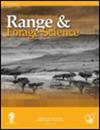1996-2019年纳米比亚东北部稀树草原林地木质覆盖变化与火灾历史和土地利用的关系
IF 1.9
4区 环境科学与生态学
Q3 ECOLOGY
引用次数: 4
摘要
在纳米比亚东北部Bwabwata国家公园的稀树草原林地中,对树木、灌木-草镶嵌物、草地和裸地的植被覆盖估算进行了量化。利用1996年至2019年期间拍摄的重复照片、航空照片和最近的卫星图像,分析了树木覆盖的变化。利用基于目标的分类技术和ecogintreble软件中的非参数随机森林分类器算法获得每种植被类型的覆盖估计。结果表明:1996-2019年,整个公园树木减少(- 10.6%),灌草马赛克植被类型增加(8.1%);与东部的11%相比,西部土地利用区树木减少最多(- 36%),灌草马赛克增加最多(17%)。森林覆盖估算的变化归因于公园东部和西部不同的季节性火灾管理措施。火灾历史(2000-2018年)显示,西部旱季晚期火灾频发,而东部旱季早期火灾频发。本研究记录的入侵阶段对生物多样性、人们的生计和旅游业产生了影响。本文章由计算机程序翻译,如有差异,请以英文原文为准。
Woody cover change in relation to fire history and land-use in the savanna-woodlands of north-east Namibia (1996–2019)
Vegetation cover estimates for trees, shrub-grass mosaics, and grassland and bare ground, were quantified in the savanna-woodland of Bwabwata National Park, north-east Namibia. Changes in woody cover were analysed using repeat photographs in combination with aerial photographs and recent satellite imagery taken between 1996 and 2019. Cover estimates for each vegetation type were obtained using object-based classification techniques and a non-parametric random forest classifier algorithm in eCognition Trimble software. Results show that over the two decades under investigation (1996–2019), trees declined (−10.6%), and the shrub-grass mosaic vegetation type increased (8.1%) across the park. The largest decline in trees occurred in the western land use areas (−36%), which also experienced the greatest increase in the shrub-grass mosaic (17%), when compared with areas in the east (11%). Variation of woody cover estimates is attributed to different seasonal fire management practices in the east versus the west of the park. The fire history (2000–2018) revealed that late dry season fires were frequent in the west, whereas in the east, early dry season fires were frequent. The stages of encroachment recorded in this study have consequences for biodiversity, people’s livelihoods, and tourism.
求助全文
通过发布文献求助,成功后即可免费获取论文全文。
去求助
来源期刊

African Journal of Range & Forage Science
ECOLOGY-ENVIRONMENTAL SCIENCES
CiteScore
4.00
自引率
14.30%
发文量
35
审稿时长
>12 weeks
期刊介绍:
The African Journal of Range & Forage Science is the leading rangeland and pastoral journal in Africa. The Journal is dedicated to publishing quality original material that advances rangeland ecology and pasture management. The journal aims to publish research of international importance from any region, but as an African journal, we are particularly interested in research from Africa and relevant to the continent. The Journal promotes both science and its application and authors are encouraged to explicitly identify the practical implications of their work. Peer-reviewed research papers and research notes deal primarily with all aspects of rangeland and pasture ecology and management, including the ecophysiology and biogeochemistry of rangelands and pastures, terrestrial plant–herbivore interactions (both domestic and wild), rangeland assessment and monitoring, effects of climate change on rangelands, rangeland and pasture management, rangeland rehabilitation, ecosystem services in support of production, conservation and biodiversity goals, and the identification and development of intensive and semi-intensive pasture and forage resources to meet livestock production needs. Articles highlighting transdisciplinary linkages among biophysical and social sciences that support management, policy and societal values are particularly encouraged. The Journal includes relevant book reviews and invited perspectives that contribute to the development of range and forage science. Letters to the editor that debate issues raised in the Journal are acceptable. The African Journal of Range & Forage Science is the official journal of the Grassland Society of Southern Africa.
 求助内容:
求助内容: 应助结果提醒方式:
应助结果提醒方式:


